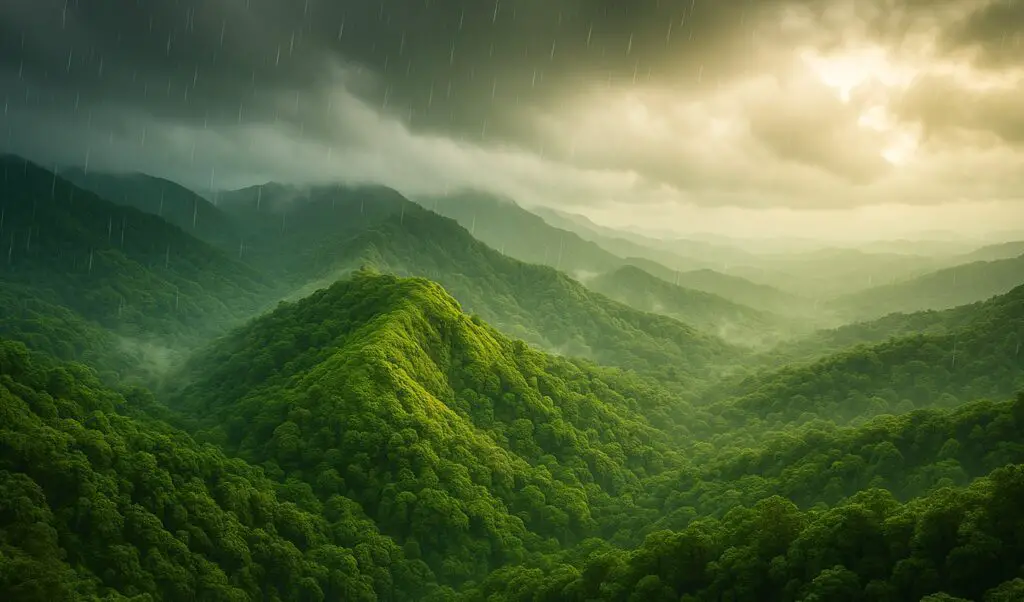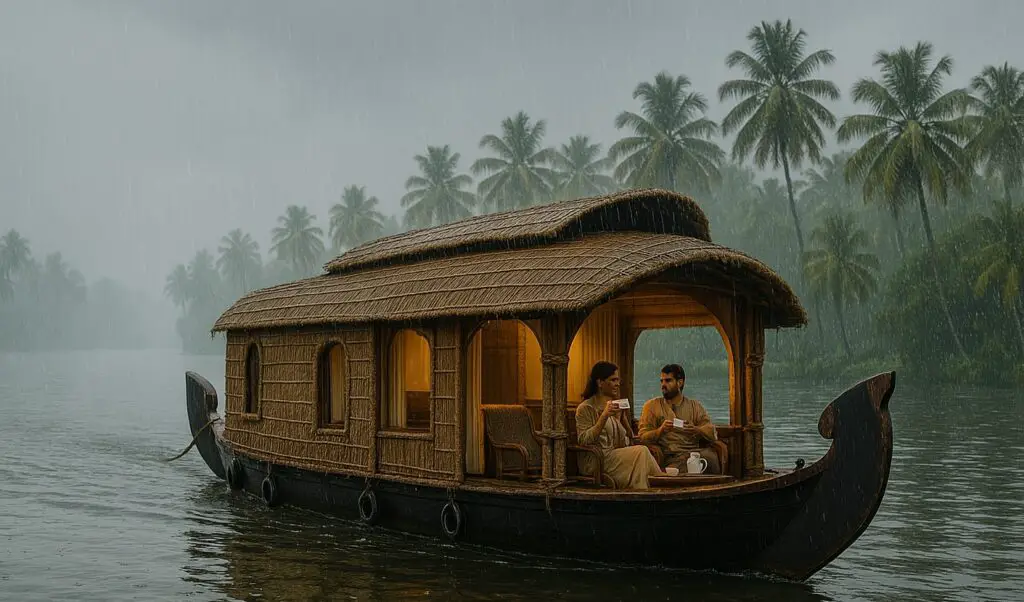Monsoon travel in India is not just a trip but an experience that transforms the way people see this charming country. The monsoon rain adds new life to India’s diverse landscapes, culture and spirit right from stunning waterfalls to lush green hills. If you have visited India during the dry months, you had probably missed out a game changing adventure. The monsoon season ranging from June to September turns the country into a paradise for nature lovers, culture enthusiasts and adventure lovers, but the question now arises why monsoon travel in India is such a big deal? Let’s talk about the reasons that make it an unforgettable experience, optimized for your curiosity and wanderlust.

In this blog, we will discuss the reasons why India is a must visit place during monsoon season, discovering hidden places, affordable advantages and some tricky tips to ensure that your journey is a smooth one. Whether you dream of foggy hill stations or colorful festivals, this blog will persuade you to grab your bags and indulge in the rains.
The Magic of India’s Monsoon Season
Indian monsoon is not merely a rain but a phenomenon that renews the nation. India with an average annual rainfall of 1200 mm, becomes a green, verdant wonderland as the rains sweep over its varied landscapes. The cities, villages, and forests are charged up with a freshness that cannot be matched by any other season.Now let’s talk about what makes this time so magical?
A Burst of Natural Beauty
Imagine standing at the edge of a cliff, watching mist swirl around green hills while waterfall roaring in the background. Monsoon travel in India brings this postcard perfect view wherever you go. Places like Kerala’s backwaters, the Western Ghats and Meghalaya’s living root bridges become even more breathtaking when drenched in rain. The season paints India in vibrant greens and silvers, offering a visual feast that is generally not seen in dry months.
Fewer Crowds, More Serenity
One of the biggest advantages of monsoon travel is Fewer tourists. Popular destinations like Goa, Shimla, and Udaipur see a dip in crowds, giving you the chance to enjoy these spots in peace. You will have the luxury of exploring without the usual hustle, making it a game changer for those who crave solitude or a relaxed pace.
Top Monsoon Destinations in India You Can’t Miss
India’s diverse and vast geography means every region has something unique to offer during the rains. Here are the must-visit destinations that shine brightest in the monsoon and why they are game changers.
Kerala: The Rain-Kissed Paradise

Kerala, often recalled as “God’s Own Country,” is a monsoon lover’s dream. The rain turns its backwaters into shimmering mirrors and its tea plantations into vibrant carpets of green. The places like Munnar and Alleppey are at their peak beauty, with mist-covered hills and tranquil boat rides. Moreover, Ayurvedic treatments are Kerala’s specialty and said to be more effective during the monsoon due to the humid climate. The low tourist traffic also means better deals on houseboats and resorts.
Meghalaya: The Abode of Clouds
If you want to experience the real power of the monsoon, travel to Meghalaya, famous for receiving the highest rainfall in India, this northeastern state has breath taking landscapes. Cherrapunji and Mawsynram, two of the wettest places on planet earth, provide jaw dropping views of waterfalls like Nohkalikai and Seven Sisters. The living root bridges, constructed by the Khasi tribe, shine under the rain, creating another worldly vibe.
Goa: A Rainy Beach Adventure
Thinking Goa is only for sunny days? Think again. Monsoon travel in Goa turns the script, converting its beaches into serene escapes and its hinterlands into lush jungles. Dudhsagar Falls swells into a roaring spectacle, while spice plantations in Ponda offer aromatic tours under the rain. The off season trip means cheaper accommodation and an opportunity to see Goa beyond its nightlife image.
Rajasthan: Desert in the Rain

Rajasthan might surprise you as a monsoon destination, but the rains bring a rare charm to this desert state. Udaipur’s lakes overflow, reflecting the palaces in a dreamy haze, while Mount Abu’s hill station blooms with greenery. The contrast of rain against the arid backdrop makes it a unique experience you won’t find in peak winter season.
Why Monsoon Travel Beats Other Seasons
Still not convinced? Let’s break down why monsoon travel in India outshines the dry seasons in ways you might not expect.
Budget-Friendly Bliss
The travel during monsoon is a pocket friendly trip. The hotels, flights and tour packages reduce prices to attract tourists during off season. For example, a luxury stays in Goa that costs you Rs 5000 per night in winter might drop to Rs 3000 during monsoon. This affordability lets you indulge in other activities like a private boat tour in Kerala or a hilly trek in Uttarakhand without spending much.
A Feast for Foodies
The monsoon season brings out India’s culinary excellence. The steaming cup of chai with hot pakoras (fritters) become a ritual in every nook and corner of the nation. The coastal regions such as Goa and Kerala serve fresh seafood while hill stations offer piping hot momos and thukpa. The rainy climate enhances the warmth and taste of these mouthwatering dishes, thus making each bite a memorable experience.
Festivals That Shine in the Rain
India’s monsoon season coincides with some of its charming and colorful festivals, for instance, Teej in Rajasthan, with its colorful processions and Onam in Kerala, with its flower carpets and boat races, are amplified by the rainy backdrop. These celebrations offer a cultural immersion that is hard to beat, turning your trip into a deeper exploration of India’s soul.
Adventure Awaits: Monsoon Activities to Try
Monsoon travel is not just about sightseeing, it is about diving into adventures that only the rains can unlock. Here’s what you can do to make your trip a thrilling game changer.
Trekking Through Misty Trails
The Western Ghats and Himalayas turn into trekking havens during the monsoon. The trails like Valley of Flowers in Uttarakhand or Rajmachi in Maharashtra offer misty vistas, wildflowers and vibrant over flowing streams. The cool damp air makes the climbs refreshing, although you will need sturdy shoes to tackle the slippery paths.
River Rafting in the Rains

Monsoon rafting is a must for thrill seekers and adventure lovers. The rivers such as the Ganges in Rishikesh or the Beas river in Manali roar with extra force providing rapids that push your mettle. It is a heart pounding way to feel India’s untamed side, with experienced guides to ensure your safety.
Waterfall Chasing
The waterfalls in India hit their peak during monsoon season and chasing them is an adventure in itself. Jog Falls in Karnataka, Athirappilly in Kerala and Bhimlat Falls in Rajasthan swell into majestic cascades during monsoon. Pack a raincoat, grab your camera and get ready for nature’s grand show.
Practical Tips for a Seamless Monsoon Trip
Monsoon travel in India is incredible, but it comes with challenges. Here are some tips how to stay prepared and make the most of your journey.
Pack Smart for the Rain
The waterproof equipment is your best friend. Pack a sturdy raincoat, quick-dry clothes and waterproof shoes with good grip. A small umbrella and a backpack cover will protect your essentials and keep them dry. Do not forget to carry insect repellent as mosquitoes are dominant in the wet season.
Plan Your Route Wisely
The heavy rains can disrupt travel plans, particularly in flood prone areas. Check the weather and road conditions before traveling. Prefer trains over buses in regions like Mumbai or Assam, where flooding is common. The hill stations may experience landslides, so travel along popular routes.
Stay Healthy and Safe
Monsoon brings a risk of waterborne diseases. Drink bottled or boiled water, avoid street food in unhygienic areas and carry basic essential medicines. A first aid kit with bandages and antiseptics is useful for small slips on wet slippery trails.
Busting Myths About Monsoon Travel in India
Some travelers shy away from India during the monsoon, but let’s debunk the myths holding you back.
It’s Too Dangerous to Travel
Although heavy rains can be inconvenient and may cause disruptions, but India’s tourist infrastructure is well equipped to handle the season. The safety measures have been put in place at major destinations and with a little advance planning, you can steer clear of the trouble spots.
Everything Is Closed
Not true, most attractions, hotels and restaurants remain open, often with special monsoon packages. Some National parks may remain close, but alternatives like spice plantations, museums and indoor markets keep you entertained.
You’ll Be Stuck Indoors

The rain does not mean confinement. Many activities just like tea estate walks or boat rides are designed specifically for the rainy season. Moreover, the rain often comes in short bursts, providing lot of time to explore between showers.
Why Monsoon Travel Changes You
Apart from views and experiences monsoon travel in India leaves an indelible impression on your soul. The sound of rain falling over leaves, the aroma of wet soil and the rare vision of rainbow forming over a hill, all these moments stay long, once the trip is over. It’s a season that makes you slow down, compelling you to enjoy the present moment. You will come back to home with tales of misty lawns, spontaneous detours and the warmth of a roadside tea shop.
For photographers, it’s a goldmine of moody shots. For couples, it’s a romantic escape under shared umbrellas. For solo travelers, it’s an opportunity to rejuvenate with nature and yourself. The monsoon unwraps the ordinary, exposing India’s raw and unfiltered beauty.
Ready to Embrace the Rains?
Monsoon travel in India is a game changer because it turns everything you know about the nation. It’s not just a season but a vibe, a feeling, a journey full of vast experiences and memories that redefines travel. From budget savings to soul stirring landscapes, the rains unlock a side of India that is hidden in plain sight. So, why wait for the sun? Grab your raincoat, plan your route and dive into the magic of India’s monsoon.
Have you ever traveled during the monsoon? Share your favorite rainy adventure in the comments. We would love to hear your story and if this post inspired you, pin it for your next trip. Let’s make monsoon travel the next big thing.
Frequently Asked Questions
1. What is the best time for monsoon travel in India?
The monsoon season in India generally ranges from from June to September, with July and August being the peak months for rainfall. For lush green meadows and less crowd, mid July to early September is ideal, although it varies with region (e.g. Kerala earlier, Northeast later).
2. Which are the top monsoon destinations in India?
The top destinations include Kerala (Munnar, Alleppey), Meghalaya (Cherrapunji, Mawsynram), Goa (Dudhsagar Falls) and Rajasthan (Udaipur, Mount Abu).
3. Is it safe to travel during the monsoon in India?
Yes, but with a little bit of planning. Avoid flood prone areas, listen to weather updates and stick to well connected routes. Pack waterproof equipment and stay cautious on slippery routes or roads prone to landslides.
4. Why is monsoon travel in India budget friendly?
The less tourists results in lower prices. The hotels, flights and tours often drop their prices by 30-50% in the off season.
5. What should I pack for a monsoon trip in India?
Pack a raincoat, waterproof shoes, quick dry clothes, an umbrella, insect repellent and a first aid kit with essential medicines. Also carry a backpack cover that keeps your equipment dry.
6. Can I enjoy adventure activities during the monsoon?
Absolutely yes. Try trekking (Valley of Flowers), waterfall chasing (Jog Falls) or river rafting (Rishikesh), but ensure safety measures with guides and proper equipment.
7. Does everything shut down during the monsoon in India?
No, it is just a myth. The most tourist spots, hotels and restaurants stay open. Some national parks may remain closed, but alternatives like plantations, museums and festivals keep you busy.
8. How does the monsoon enhance India’s beauty?
The rain transforms dry landscapes into lush green outfields, swells waterfalls and adds a misty charm to hills. The earthy aroma and vibrant colors make every view perfect for capturing selfies and stunning photos.
Disclaimer: Monsoon road trips can be thrilling but also unpredictable and little risky due to heavy monsoon rains. So its highly advisable to verify local weather updates and prioritize safety measures while traveling.